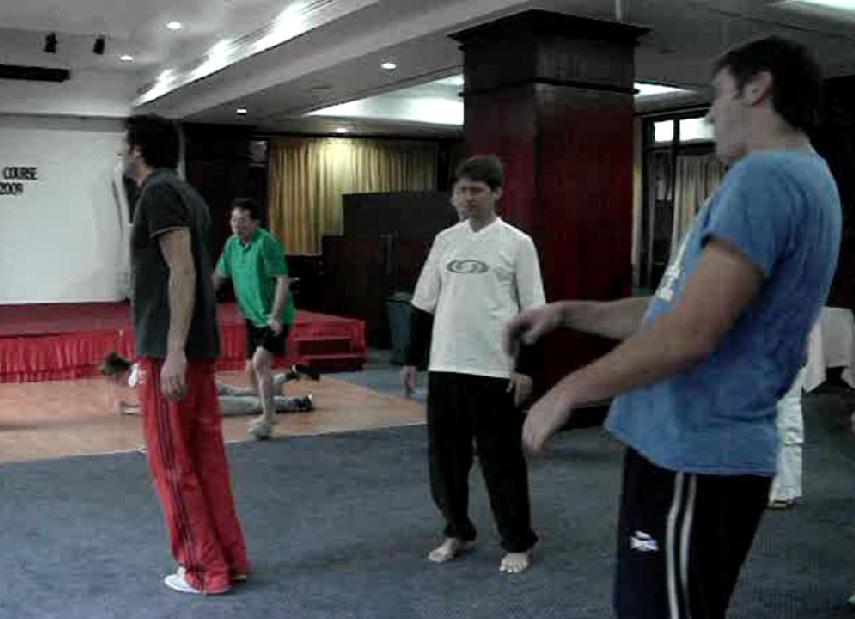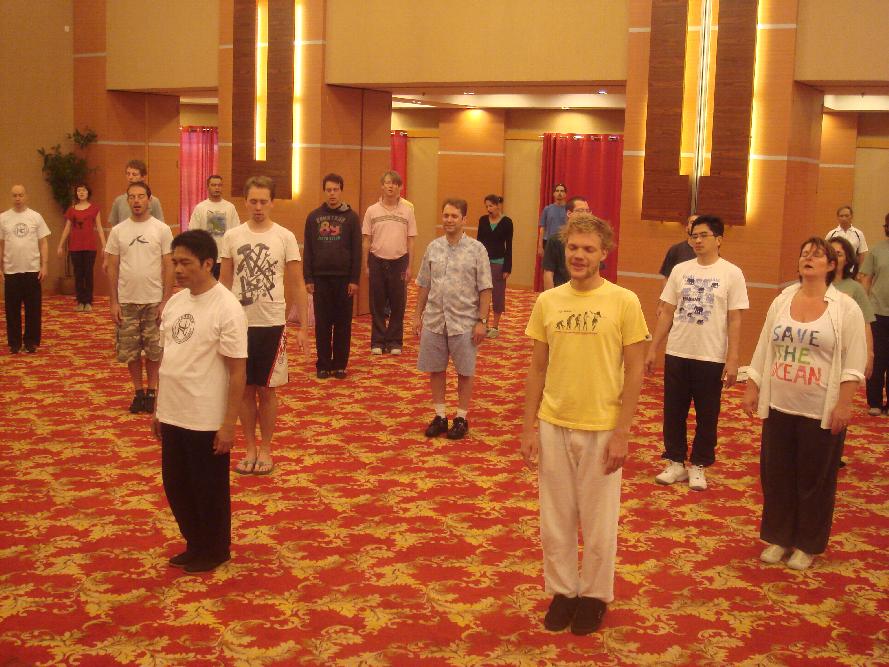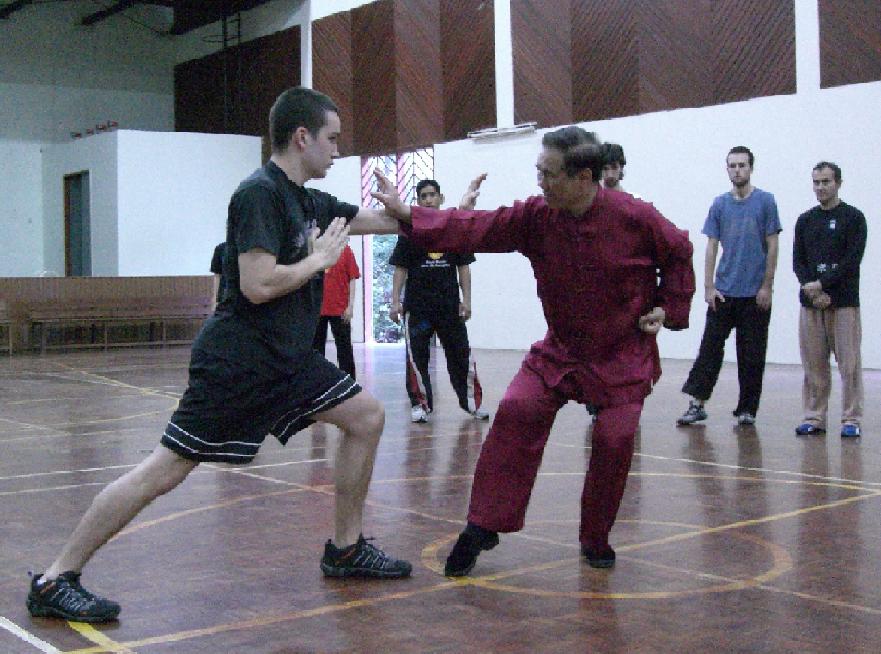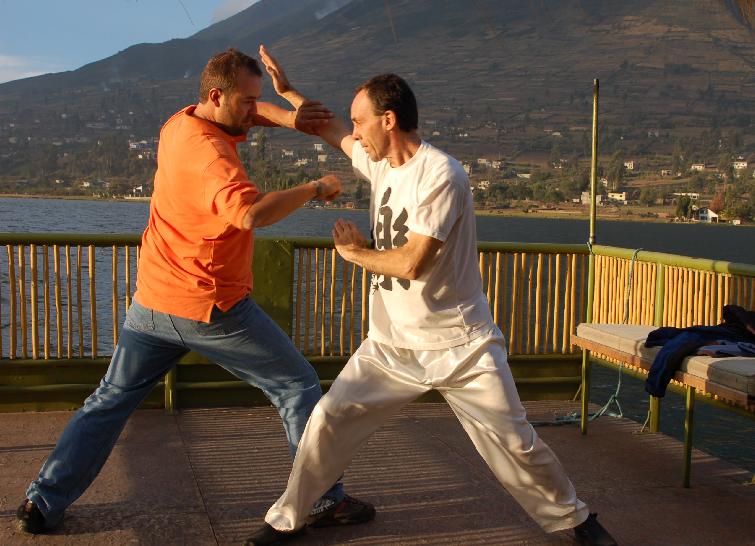SELECTION OF QUESTIONS AND ANSWERS
MAY 2011 PART 2

It may be hard to be believed, but a good chi flow generated by any chi kung exercise can overcome any illness!
Question 1
What techniques are recommended to apply chi kung when one has flu and common cold?
— Joaquin, Spain
Answer
There are two approaches in overcoming any pain and illness, namely holistic and thematic.
In the holistic approach, any chi kung technique can overcome flu and common cold. This may sound odd to many people, especially those used to the modern Western medical paradigm.
But according to the chi kung paradigm, when chi flow is harmonious, yin-yang harmony will be restored. Any genuine chi kung technique will generate a chi flow. Yin-yang harmony results in good health, which means that headache and common cold no longer exist.
In the thematic approach, Turning Head and Separating Water are good for overcoming flue and common cold.
Question 2
My orthopedic surgeon says that I have sensitive knees and a torn meniscus that does not require operation. I like standing meditation, but can the standing meditation hurt my knees?
Answer
If you are referring to the standing meditation we do in our chi kung practice, it will not only not hurt your knees, it can help you to recover from your knee problems. But if you refer to standing meditation done by most other people, it does hurt. For them it is better to adopt another meditation position where there is no stress on the knee, such as sitting upright on a chair.
Why is it that our standing meditation does not hurt your knees even when you have some knee problems, whereas standing meditation performed by most other people does? It is because when we perform standing meditation, chi is flowing down our legs, whereas this does not normally happen to most other people. It is the flowing chi that supports us when we stand upright, but most other people would have to depend much on their bones and muscles, thus aggravating the knee problem.

Participants at the Chi Kung Review Course in 2010 enjoying Standing Meditation
Question 3
I visited my former Aikido Sensei just to say Hi. He can sense and use qi, and has internal force but he also has blockages -- the most evident ones being that he suffers from frequent headaches and always has pain in the knees. Yet, I believe he is one of the top martial artists in the country..
— Thomas, UK
Answer
Our school is different from many martial art schools, including kungfu schools, in this aspect. In most other schools, the focus is on combat, sometimes to the extent of even sacrificing their health. This is particularly the case with non-kungfu styles. Boxers and Karatekas, for example, become more unhealthy the more they pursue their arts.
Originally the first concern of kungfu training was good health. There is an important kungfu saying as follows, "mei fong sun, sin keong sun", which means "before one practices for combat, he must be healthy first". However, many kungfu schools today have lost the essence of kungfu training, and like other martial art schools have sacrifice health for combat.
Our school, however, is still very traditional. While we placed much importance on combat efficiency, our top priority is good health, vitality and longevity.
Question 4
My sensei asked me to perform the following exercise. While in seiza position, extend your arm to the front so that your partner grabs your wrist with both of his hands ("morotedori" in Japanese) and pushes your arm towards you, trying to bend it with external strength. You should be relaxed and with no tension, and your arm should be unbendable.
Answer
This is a good way to demonstrate the power of chi. If you are relaxed and let chi flow effortlessly along your arm, someone gripping your wrist would be unable to bend your arm with external strength. But it would be a different story if an opponent has internal force and use tiger-claw or eagle-claw.

While we place much important to combat efficiency, our priorities in our kungfu training are good health, vitality and longevity
Question 5
I did not want to enter the tatami and try the exercise but I felt it was not proper to refuse. I sat in seiza and my knees started hurting a lot. He told me to do Abdominal Breathing throughout the exercise.
Answer
Different schools and different teachers have different philosophy and different ways of teaching. The seiza position is widely used in many Japanese arts.
But in our school, we do not use it because from our perspective it blocks chi flow in the legs.
Question 6
When my Sensei was doing the exercise on me, his palm was facing directly at my heart. I became a little apprehensive when I saw this, but didn't do anything about it.
Answer
It is not advisable to let someone place his palm directly facing your heart. I recall seeing a Taijiquan master placing his palm directly on the solar plexus of a senior student while teaching the student Pushing Hands. I was shocked that he actually pushed hard at the student's solar plexus, while the student resisted it. It was more shocking that he was a well-known master, and that both he and the students did not realize he was (unintentionally) causing the student much harm.
Understandably, it was difficult for you or any student to tell the master not to do what he was doing even when you knew it was harmful for you. But if a similar situation happens again, you have to do something. You may, for example, move your position so that his palm does not face your heart. If he direct his palm at your heart again, you move a second time. If he repeats a third time, you move a third time too.
Hopefully this will stop him from placing his palm in a way which may cause you harm. But if he persists or asks you not to move away, you can politely tell him that it hurts. If he still persists, you have to politely tell him that you prefer not to carry on and hopes he would not mind. You should then perform some chi flow as soon as possible, but not n his presence, to clear off any harmful effect.

Taijiquan can be very fast, as shown here by Sifu Jose Antonio and Sifu Rama while sparring on a river-boat
Question 7
I pushed and couldn't bend his arm, as expected. Then my turn came. I couldn't do Abdominal Breathing. I couldn't even enter a chi kung state of mind. It was too painful to be in seiza. I closed my eyes to try to relax but he told me to open them, I looked away as a substitute to closing my eyes but he told me to look to the front. When we finished, my knees hurt a lot. I felt like a wreck. My knees hurt and were sore for the next 10 days.
I wondered if these unpleasant effects were the result of doing that exercise, specially because of the hand directly in front of my heart, or just my imagination. Luckily, I'm all fine now, so I no longer worry about it.
Answer
You are right. You Aikido teacher caused you some injury but he himself was unaware of it. But don't worry about it now. Even if he had caused some injury, your chi flow was more than enough to overcome it.
Question 8
I just started reading and studying kung fu and think it is a great martial art because of the benefits.
— Marc, Germany
Answer
Practicing kungfu will give many benefits, if you learn from a good teacher and practice correctly.
Unfortunately, nowadays good kungfu teachers are hard to find. For most students it is even harder to practice correctly, which includes practicing regularly and conscientiously.
Hence, many kungfu students today not only do not derive the benefits kungfu is supposed to give, but become more unhealthy and stressful as a result of their practice. This may seem odd, but is true.
Question 9
I read your book about the different forms of Shaolin Kung Fu. I want to practice these martial arts. but I was wondering about which style of kung fu is fast and aggressive.
Answer
All styles of kungfu, including Taijiquan, can be fast and aggressive, otherwise they cannot be effective in combat. They can also be performed slowly and gracefully.
Many people, including Taiji practitioners, think that Taijiquan is slow, and cannot be fast. In fact, a Taiji "master" once told me that if it were fast, it could not be Taijiquan! He also told me that Taijiquan must be soft, it should not be hard. This is incorrect.
When one first learns Taijiquan, it is usually performed slowly and without using any muscular strength. But as he progresses, Taijiquan can be very fast and very powerful or hard. If Taijiquan were only soft and slow, it could not be a martial art. But many Taiji practitioners themselves do not know that Taijiquan is a wonderful martial art.
While the combat function of kungfu is important, and here being fast and aggressive is necessary, you should practice kungfu for its other benefits too. When practiced correctly, kungfu contributes to good health, vitality and longevity. It also enables you to have better performance in your daily life.
LINKS
Selected Reading
- Courage and Confidence in Teaching and Healing
- How to Improve your Mental Clarity
- How would a Wing Choon practitioner counter side attacks?
- South to the Old Smoky
- How do Masters Spar?
